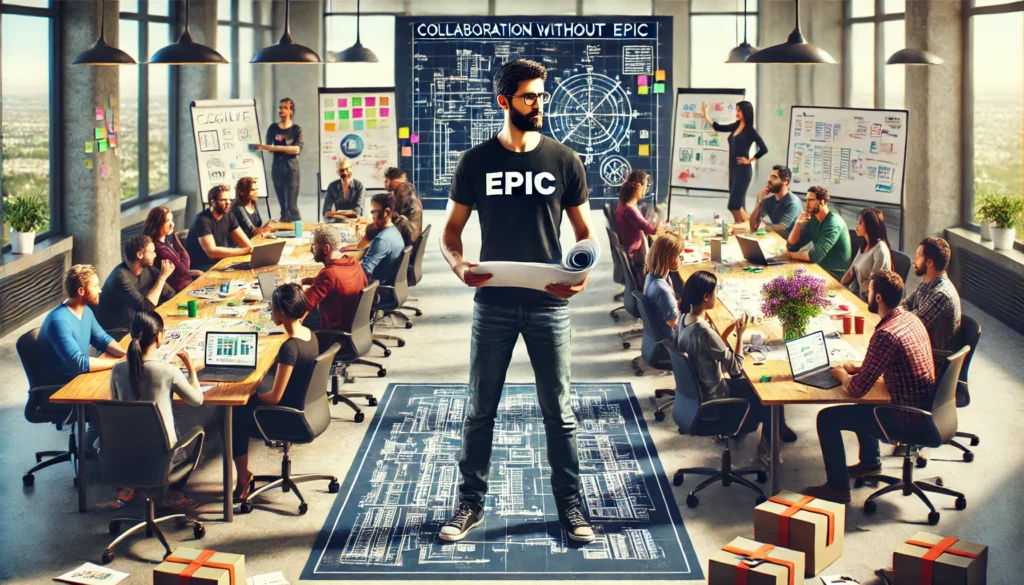 Back to Resources
Back to Resources
Recently I’ve encountered a hesitation towards co-design…
There’s a perception that sharing methods, practices, and working documents before they are ‘finalised’ as part of the build process equates to “guerrilla sourcing”—a term some use to describe a kind of reckless gathering of content that muddies the water and adds little value. I’m not sure why this mindset exists, but I think it stems from a fear that opening up our work to others, somehow diminishes our individual expertise and reduces the perceived value within the organisation – or alternatively a mistaken belief that others have little value to add.
However, this perspective overlooks the substantial benefits that co-design and collaboration bring – especially in the Transformational context. Sharing working documents with a wider audience isn’t about surrendering control; it’s about fostering an environment where collective knowledge sharing and ownership thrives.

Breaking Down Silos:
Many organisations aim to break down silos to improve communication and efficiency. Ironically, resisting co-design reinforces these very silos. By keeping knowledge confined, we limit cross-functional learning and hinder the organisation’s ability to adapt and grow. People learn more effectively through hands-on experience and active participation than they do by simply reading process guides, or presentations.
I’ve seen teams that embrace co-design develop stronger rapport and more effective working habits. Collaboration allows for the exchange of diverse perspectives, challenging existing assumptions and leading to more robust solutions. This collective effort doesn’t diminish individual contributions—it amplifies them within a broader context that benefits everyone.
Leveraging Existing Investments:
Whenever I hear the words “we can’t guerrilla source this”, in my head I ask myself “And what’s so wrong with guerrilla sourcing anyway?”. The concern over “guerrilla sourcing” often ignores the value of building upon previous investments. Organisations have already devoted time and resources to buy or develop a vast set of capabilities and practices, so leveraging this existing knowledge isn’t about cutting corners; it’s a strategic move to maximise efficiency and innovation.
In practice, when teams view shared resources as a foundation rather than a threat, they unlock new levels of creativity. Leveraging the experience of others should be standard practice, fostering an environment where knowledge flows freely and everyone benefits.

Reducing Resistance Through Inclusion
Sharing working documents and involving a wider audience can actually reduce resistance within the organisation. When individuals are included in the development process, they feel a sense of ownership and are more likely to support the outcomes. This inclusion transforms potential sceptics into advocates who contribute positively to change initiatives.
In organisations where co-design is embraced, I’ve observed smoother transitions and more successful implementations of new strategies. People are naturally more committed to ideas they helped shape.
Challenging Perspectives
Co-design offers opportunities for team members (on both sides of this debate) to challenge their own perspectives and consider alternative approaches. This collaborative environment encourages continuous learning and adaptation—essential components of personal and organisational growth.
By sharing experiences and expertise, we raise the bar collectively. Team members are motivated to rise to new challenges, fostering a culture of excellence and innovation.

It’s important to recognise that resisting co-design contradicts the very goals many organisations strive for, such as breaking down silos and building capability. By embracing collaboration, we align our actions with these objectives, creating a more cohesive and effective organisation.
Co-design is not about relinquishing control or devaluing individual contributions. It’s about acknowledging that our collective strength surpasses individual efforts. By collaborating, we enhance our value, promote innovation, and drive the organisation forward.
Let’s shift our perspective on sharing knowledge. Rather than viewing it as “guerrilla sourcing,” we should see it as a strategic approach to leverage existing capabilities and foster a culture of continuous improvement.
I encourage professionals and organisations to reconsider their stance on co-design. Embrace it as a means to reduce resistance, build capability, and achieve shared success. Sharing knowledge doesn’t weaken our position; it strengthens the entire team and, by extension, the organisation.
By working together and leveraging our combined experiences, we can overcome challenges, drive meaningful change, and reach new heights that wouldn’t be possible in isolation. Co-design therefore, has a value all of it’s own.
If you want to hear more about our experiences and how we can help you with improving your working habits, give us a call on 1300 550 887! Let us help you create a deliberately different future.






